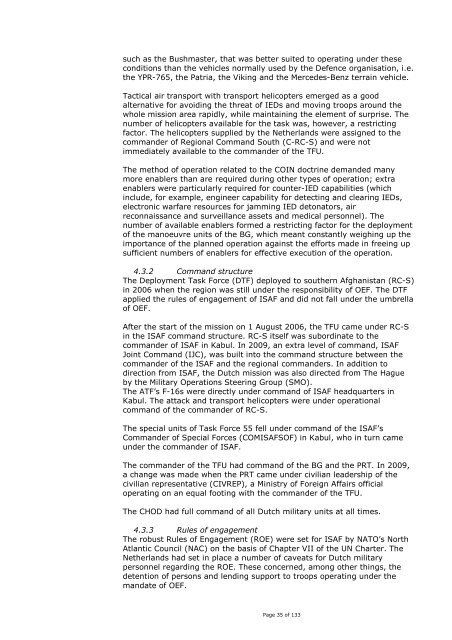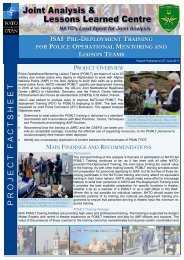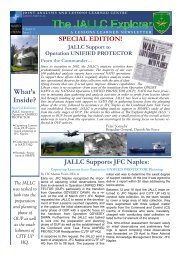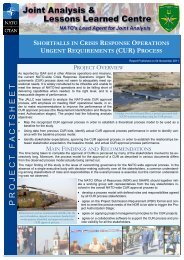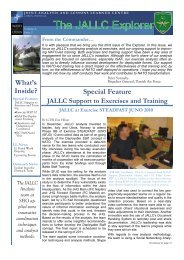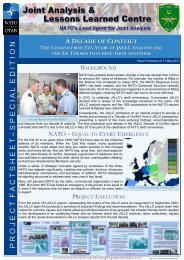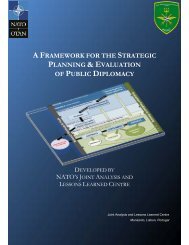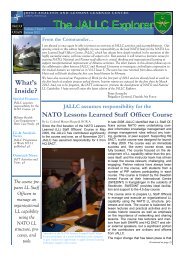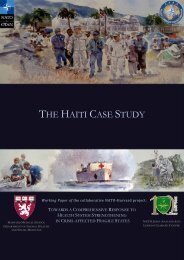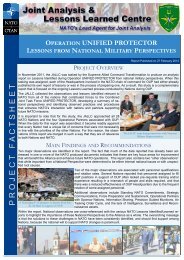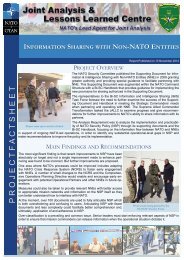The Dutch cont<strong>in</strong>gent commander was the area representative of the<strong>Netherlands</strong> Chief of Defence (CHOD) and provided adm<strong>in</strong>istrative supportto Dutch <strong>ISAF</strong> troops. The Dutch cont<strong>in</strong>gent commander was also thedesignated ‘red card holder’, who was authorised to call a halt to theoperations of Dutch troops <strong>in</strong> the event that the conditions for operations,as set by the Dutch government, had not been met. The cont<strong>in</strong>gentcommand was based at Kandahar Airfield.In the Article 100 letter of 2005, the strength of the troops for Uruzgan hadbeen set at 1,200. However, the number of troops tak<strong>in</strong>g part <strong>in</strong> themission rose to 2,000 <strong>in</strong> 2009, ow<strong>in</strong>g to the expansion of the AfghanDevelopment Zones (ADZs), the lack of re<strong>in</strong>forcement of the Afghan armyand police force, the necessity for high enough numbers of troops <strong>in</strong> theADZs <strong>in</strong> order to offer sufficient protection to the civilian population,<strong>in</strong>creas<strong>in</strong>g resistance from <strong>in</strong>surgents, and the need for more or newcapabilities (counter-IED and air reconnaissance capabilities, for example).The demand for more troops was bound by f<strong>in</strong>ancial constra<strong>in</strong>ts and thearmed forces’ susta<strong>in</strong>ment capability. With<strong>in</strong> this field of tension, there wascont<strong>in</strong>uous deliberation tak<strong>in</strong>g place at the M<strong>in</strong>istry of Defence <strong>in</strong> The Hagueregard<strong>in</strong>g the evident advantages of more troops, the division of troops <strong>in</strong>tocombat personnel and support personnel (manoeuvre and enablerelements) and the f<strong>in</strong>ancial consequences related to the numbers of troopsdeployed. A total number of 20,000 Dutch military personnel took part <strong>in</strong><strong>ISAF</strong>. The total number of Dutch civilian personnel act<strong>in</strong>g with<strong>in</strong> the TFUdur<strong>in</strong>g the <strong>2006</strong>-<strong>2010</strong> period amounted to 130.4.3.1.1 TFUThe Dutch military presence <strong>in</strong> Uruzgan was given the name of Task ForceUruzgan (TFU), and had an <strong>in</strong>itial strength of 950 military personnel. At thestart of the mission, the civilian component comprised three persons,<strong>in</strong>creas<strong>in</strong>g to twelve persons later on <strong>in</strong> the mission. The mann<strong>in</strong>g aspect ofthe TFU, and with it the civilian component, is expla<strong>in</strong>ed further <strong>in</strong>paragraph 5.3.1.1. The TFU was structured as follows: a staff ofapproximately 100 personnel, a Prov<strong>in</strong>cial Reconstruction Team (PRT) of amaximum of 60 persons, a Battle Group (BG, ground-based combat unit)compris<strong>in</strong>g approximately 450 military personnel, and support elements.The emphasis of the deployment was on the PRT and its activities and onestablish<strong>in</strong>g the presence of Afghan government authorities, with the BGact<strong>in</strong>g as a combat unit and the PRT act<strong>in</strong>g <strong>in</strong> support of the Afghanauthorities.4.3.1.2 ATFThe Air Task Force (ATF) was tasked with support<strong>in</strong>g <strong>ISAF</strong> units byprovid<strong>in</strong>g air support, <strong>in</strong>clud<strong>in</strong>g reconnaissance and surveillance, with F-16fighter aircraft and Apache attack helicopters. The ATF also provided tacticalair transport by means of its transport helicopters. The F-16s and thetransport helicopters operated from Kandahar airfield, while the Apacheattack helicopters were based at Tar<strong>in</strong> Kowt. The ATF was available to all<strong>ISAF</strong> units and not restricted to support<strong>in</strong>g Dutch units only. The strengthof the ATF stood at approximately 150 personnel. In addition to the ATF,Dutch military transport aircraft made a major effort <strong>in</strong> provid<strong>in</strong>g strategicair transport between the <strong>Netherlands</strong> and Afghanistan.4.3.1.3 Manoeuvre units and enablersThe nature of the terra<strong>in</strong> and the <strong>in</strong>surgents’ method of operation were an<strong>in</strong>fluence on the requirement regard<strong>in</strong>g transport assets and support units,the enablers. Particulates, the rocky terra<strong>in</strong> and particularly the impact ofIEDs on vehicles resulted <strong>in</strong> a requirement for a different type of vehicle,Page 34 of 133
such as the Bushmaster, that was better suited to operat<strong>in</strong>g under theseconditions than the vehicles normally used by the Defence organisation, i.e.the YPR-765, the Patria, the Vik<strong>in</strong>g and the Mercedes-Benz terra<strong>in</strong> vehicle.Tactical air transport with transport helicopters emerged as a goodalternative for avoid<strong>in</strong>g the threat of IEDs and mov<strong>in</strong>g troops around thewhole mission area rapidly, while ma<strong>in</strong>ta<strong>in</strong><strong>in</strong>g the element of surprise. Thenumber of helicopters available for the task was, however, a restrict<strong>in</strong>gfactor. The helicopters supplied by the <strong>Netherlands</strong> were assigned to thecommander of Regional Command South (C-RC-S) and were notimmediately available to the commander of the TFU.The method of operation related to the COIN doctr<strong>in</strong>e demanded manymore enablers than are required dur<strong>in</strong>g other types of operation; extraenablers were particularly required for counter-IED capabilities (which<strong>in</strong>clude, for example, eng<strong>in</strong>eer capability for detect<strong>in</strong>g and clear<strong>in</strong>g IEDs,electronic warfare resources for jamm<strong>in</strong>g IED detonators, airreconnaissance and surveillance assets and medical personnel). Thenumber of available enablers formed a restrict<strong>in</strong>g factor for the deploymentof the manoeuvre units of the BG, which meant constantly weigh<strong>in</strong>g up theimportance of the planned operation aga<strong>in</strong>st the efforts made <strong>in</strong> free<strong>in</strong>g upsufficient numbers of enablers for effective execution of the operation.4.3.2 Command structureThe Deployment Task Force (DTF) deployed to southern Afghanistan (RC-S)<strong>in</strong> <strong>2006</strong> when the region was still under the responsibility of OEF. The DTFapplied the rules of engagement of <strong>ISAF</strong> and did not fall under the umbrellaof OEF.After the start of the mission on 1 August <strong>2006</strong>, the TFU came under RC-S<strong>in</strong> the <strong>ISAF</strong> command structure. RC-S itself was subord<strong>in</strong>ate to thecommander of <strong>ISAF</strong> <strong>in</strong> Kabul. In 2009, an extra level of command, <strong>ISAF</strong>Jo<strong>in</strong>t Command (IJC), was built <strong>in</strong>to the command structure between thecommander of the <strong>ISAF</strong> and the regional commanders. In addition todirection from <strong>ISAF</strong>, the Dutch mission was also directed from The Hagueby the Military Operations Steer<strong>in</strong>g Group (SMO).The ATF’s F-16s were directly under command of <strong>ISAF</strong> headquarters <strong>in</strong>Kabul. The attack and transport helicopters were under operationalcommand of the commander of RC-S.The special units of Task Force 55 fell under command of the <strong>ISAF</strong>’sCommander of Special Forces (COM<strong>ISAF</strong>SOF) <strong>in</strong> Kabul, who <strong>in</strong> turn cameunder the commander of <strong>ISAF</strong>.The commander of the TFU had command of the BG and the PRT. In 2009,a change was made when the PRT came under civilian leadership of thecivilian representative (CIVREP), a M<strong>in</strong>istry of Foreign Affairs officialoperat<strong>in</strong>g on an equal foot<strong>in</strong>g with the commander of the TFU.The CHOD had full command of all Dutch military units at all times.4.3.3 Rules of engagementThe robust Rules of Engagement (ROE) were set for <strong>ISAF</strong> by NATO’s NorthAtlantic Council (NAC) on the basis of Chapter VII of the UN Charter. The<strong>Netherlands</strong> had set <strong>in</strong> place a number of caveats for Dutch militarypersonnel regard<strong>in</strong>g the ROE. These concerned, among other th<strong>in</strong>gs, thedetention of persons and lend<strong>in</strong>g support to troops operat<strong>in</strong>g under themandate of OEF.Page 35 of 133
- Page 1 and 2: Final evaluationNetherlands contrib
- Page 3 and 4: High mountainsLow mountainsPlains a
- Page 5 and 6: Table of ContentsDutch military per
- Page 7 and 8: Dutch military personnel deceased i
- Page 9 and 10: Page 9 of 133
- Page 11 and 12: 1 IntroductionThe government would,
- Page 13 and 14: The structure of the final evaluati
- Page 15 and 16: 2 The international presence in Afg
- Page 17 and 18: insurgents in, particularly, the ea
- Page 19 and 20: 3 Netherlands policy for participat
- Page 21 and 22: Netherlands’ presence. Furthermor
- Page 23 and 24: “The objectives of this stabilisa
- Page 25 and 26: In December 2005, the Netherlands g
- Page 27 and 28: The expectation is that meaningful
- Page 29 and 30: 3.6.2 Implementation of national pr
- Page 31 and 32: 4 Implementation of the mission and
- Page 33: tasks to fulfil in the area of secu
- Page 37 and 38: Afghan partner unit, at all times o
- Page 39 and 40: northern part of Deh Rawod in 2007.
- Page 41 and 42: in large and small bases, while con
- Page 43 and 44: previously thought and comprised a
- Page 45 and 46: Apart from facilitating training an
- Page 47 and 48: If operations in close proximity of
- Page 49 and 50: As previously mentioned, the preven
- Page 51 and 52: - Between 2006 and 2010, the number
- Page 53 and 54: government of Chora in January 2010
- Page 55 and 56: At the beginning of the Dutch missi
- Page 57 and 58: intermediary of TLO and political a
- Page 59 and 60: interest for filling judicial posit
- Page 61 and 62: During the Uruzgan mission, a great
- Page 63 and 64: structurally change governance in U
- Page 65 and 66: development programmes. Before the
- Page 67 and 68: also the way in which Afghans perce
- Page 69 and 70: tailored to the real needs of the p
- Page 71 and 72: Gizab had increased and there was a
- Page 73 and 74: The DCU programme devoted and still
- Page 75 and 76: purpose of these loans, cooperative
- Page 77 and 78: In view of the lack of enthusiasm a
- Page 79 and 80: 5 Expenditure for the mission and i
- Page 81 and 82: Overview of long-term expenditure a
- Page 83 and 84: expenditure related to the deployme
- Page 85 and 86:
Multi-year expenditure, Foreign Aff
- Page 87 and 88:
explosive ordnance disposal, armour
- Page 89 and 90:
this situation as constraining, for
- Page 91 and 92:
organised at a later stage. In addi
- Page 93 and 94:
occupational social workers and the
- Page 95 and 96:
Mercedes Benz terrain vehicle, the
- Page 97 and 98:
6 ConclusionsThis chapter begins wi
- Page 99 and 100:
The first part of the central quest
- Page 101 and 102:
At the end of 2005, the Afghan auth
- Page 103 and 104:
province. This, too, was done by me
- Page 105 and 106:
area, increased sales of agricultur
- Page 107 and 108:
ISAF and the OEF led to extra coord
- Page 109 and 110:
d. The recommendations from advisor
- Page 111 and 112:
Page 111 of 133
- Page 113 and 114:
Annex A, Afghanistan Compact Benchm
- Page 115 and 116:
end-2010, reforms will strengthen t
- Page 117 and 118:
Afghan Cultural HeritageA comprehen
- Page 119 and 120:
Private Sector Development and Trad
- Page 121 and 122:
Annex B, Results of the socio-econo
- Page 123 and 124:
EducationTLO data:• In 2006 there
- Page 125 and 126:
Overview of the number of children
- Page 127 and 128:
Annex C, Chronology200522 December:
- Page 129 and 130:
July: microcredit provider World Co
- Page 131 and 132:
Annex D, List of abbreviations3DADZ
- Page 133:
Page 133 of 133


